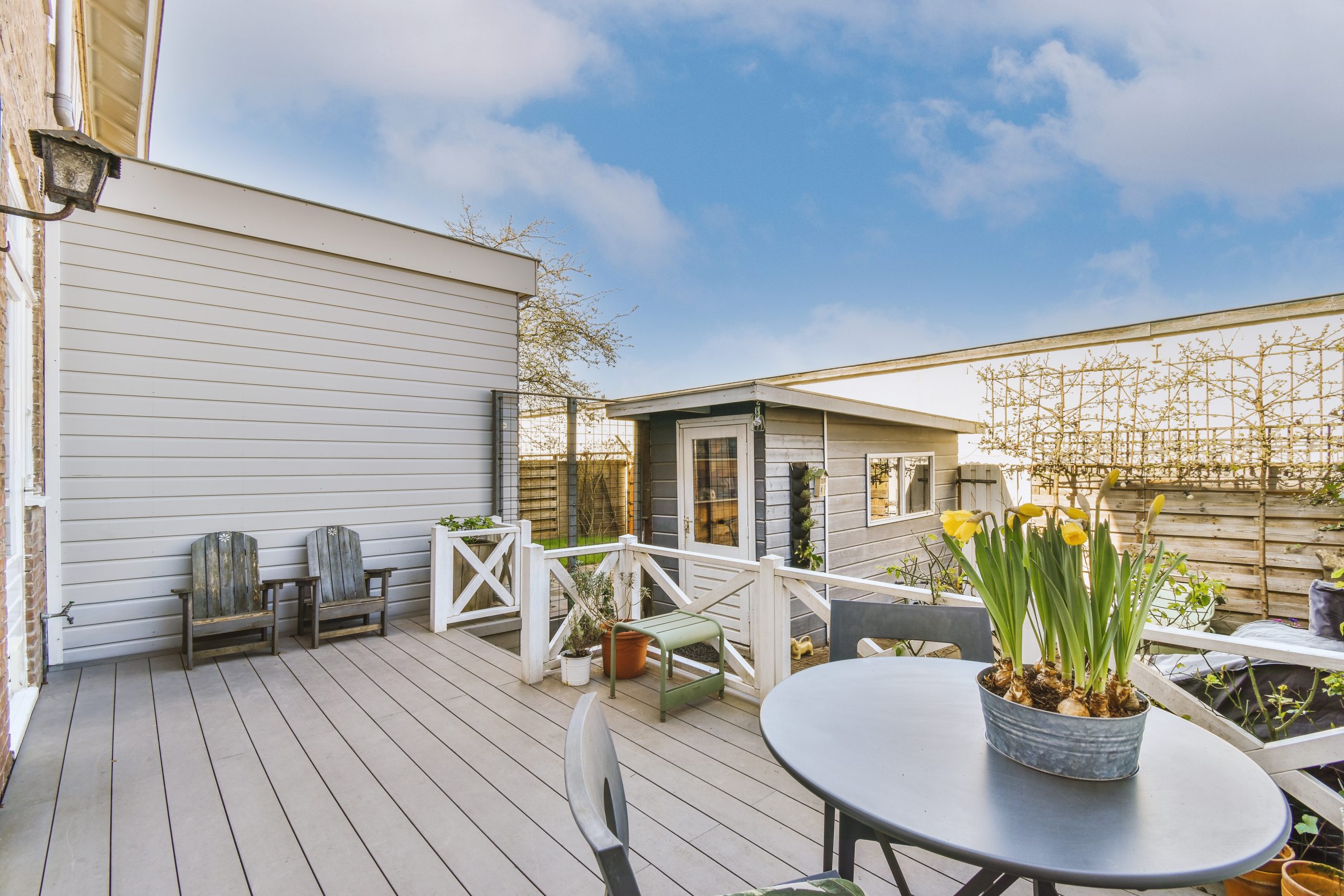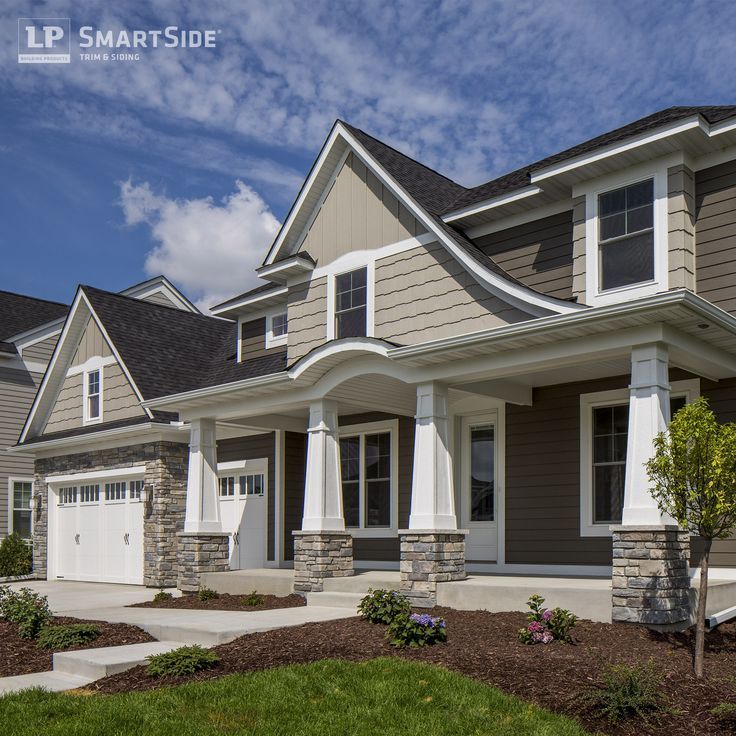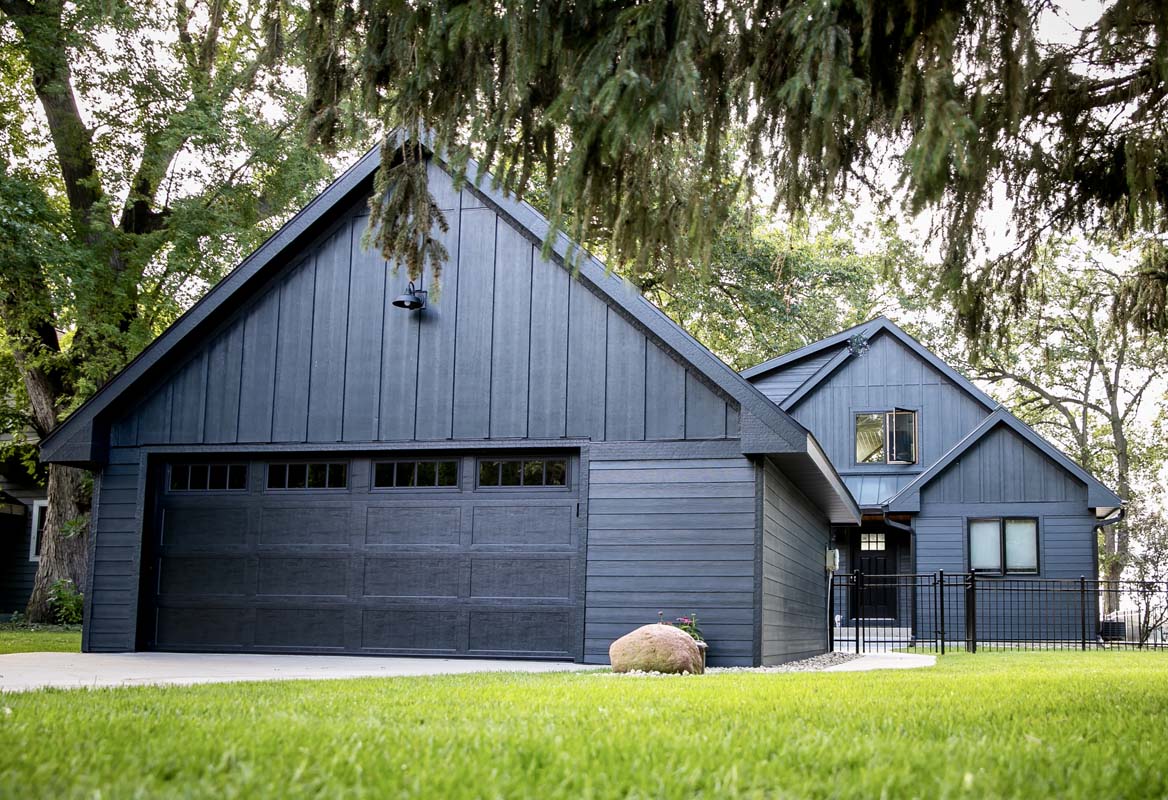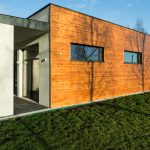
With so many home exterior house siding options available today, homeowners can choose from a wide range of materials and designs. Whether you’re exploring classic wood, modern metal siding, or low-maintenance vinyl, there are many different types of siding styles that offer durability, curb appeal, and flexibility for your home.
Some siding is also better suited for harsh weather, moisture, or high winds. Fiber cement and steel siding are highly durable, while real wood offers a natural look but often requires repainting and touch-up. Popular options like LP SmartSide siding or James Hardie mimic the look of real wood with lower maintenance. Vinyl siding is known for its affordability, variety of colors, and easy installation.
From stone veneer siding to aluminum and resin-based styles, each option comes with its maintenance costs, appearance, and performance benefits.
Types of house siding materials
If you’re looking at different kinds of house siding material options for your home, it helps to understand what’s out there and how each one performs. The most common materials include vinyl, insulated vinyl, wood, engineered wood, composites, metal, fiber cement, concrete panels, stone, manufactured stone, brick, and stucco.
Each offers its own balance of cost, durability, energy efficiency, and curb appeal, along with specific pros and cons when it comes to handling Wisconsin’s cold winters, summer storms, and shifting seasons.
Let’s take a closer look at each material.
From full siding replacements to a fresh coat of paint, we handle exterior upgrades that enhance curb appeal and stand up to Wisconsin weather. Let us help you make your home look its best.
WOOD SIDING
- Cost Range: $6 to $12 per square foot (medium to high). Installation can increase with trim complexity or vertical paneling.
- Durability / Lifespan: 20 to 40 years with regular care. Susceptible to mildew, insects, rot, and moisture damage.
- Maintenance Needs: High maintenance. Requires repainting or sealing every 3 to 7 years and regular cleaning.
- Energy Efficiency / Insulation: R-value around 0.81 per inch. Needs added insulation underneath.
- Appearance / Aesthetic Flexibility: Offers a genuine look with many profile options. Paintable and stainable for a wide range of colors.
- Environmental Impact: Sustainable when responsibly sourced. Biodegradable and low manufacturing energy.
- Climate Suitability: Can warp or rot in Wisconsin’s moisture without upkeep. Not flame retardant.
- Popular Use Cases / Home Styles: Farmhouses, cabins, historical homes, and lakefront houses.
Pros:
- Genuine look of real wood
- Highly customizable with color options
- Environmentally friendly
Cons:
- Frequent repainting and sealing are needed
- Vulnerable to weather and insects
- Higher maintenance costs
VINYL SIDING

- Cost Range: $3 to $8 per square foot (low to medium). One of the easiest types to install.
- Durability / Lifespan: 20 to 40 years. It can become brittle in extreme cold. Dents from hail or a strong impact.
- Maintenance Needs: Very low maintenance. Just occasional washing.
- Energy Efficiency / Insulation: Basic vinyl offers little insulation. Often paired with foam sheathing behind.
- Appearance / Aesthetic Flexibility: Available in a wide range of colors and textures. Some styles mimic the look of wood.
- Environmental Impact: Made from PVC. Not biodegradable, but newer styles use recycled content.
- Climate Suitability: Performs well in Wisconsin with added insulation. May crack under extreme freeze-thaw cycles.
- Popular Use Cases / Home Styles: Suburban homes, starter homes, budget-conscious remodels.
Pros:
- Affordable and easy to install
- Many types and color options
- Low maintenance
Cons:
- Less insulation unless upgraded
- Can crack or dent
- Environmental concerns with PVC
INSULATED VINYL SIDING

- Cost Range: $6 to $12 per square foot (medium to high). More costly than basic vinyl.
- Durability / Lifespan: 25 to 40 years. Extra foam core adds impact resistance.
- Maintenance Needs: Still low maintenance. Occasional cleaning is needed.
- Energy Efficiency / Insulation: R-value around 2.0 to 3.5. Provides noticeable improvement in thermal performance.
- Appearance / Aesthetic Flexibility: Comes in pre-finished panels with wood-like textures. Limited repainting ability.
- Environmental Impact: Same material as vinyl but with added foam. Less eco-friendly due to added production.
- Climate Suitability: Better insulation for Wisconsin winters. Helps resist drafts and reduce energy loss.
- Popular Use Cases / Home Styles: Newer builds, energy-conscious upgrades, remodels.
Pros:
- Improved insulation
- Maintains vinyl’s low maintenance
- Long-lasting and dent-resistant
Cons:
- Higher price point
- Limited recyclability
ENGINEERED WOOD SIDING

- Cost Range: $5 to $10 per square foot (medium). Easier to install than natural wood.
- Durability / Lifespan: 20 to 30 years. More resistant to moisture, insects, and impact.
- Maintenance Needs: Lower maintenance than wood. Comes pre-primed or pre-finished.
- Energy Efficiency / Insulation: Minimal insulation on its own. Can pair with foam layers.
- Appearance / Aesthetic Flexibility: Very good at mimicking natural wood siding. Comes in a variety of styles and colors.
- Environmental Impact: Often made from wood fiber and resin. Some options include recycled content.
- Climate Suitability: Performs well in cold climates. More moisture resistant than wood.
- Popular Use Cases / Home Styles: Modern craftsman homes, cottages, and new builds.
Pros:
- Looks like wood without the high maintenance
- Pre-finished options reduce upkeep
- Moisture-resistant
Cons:
- Still vulnerable to damage without sealing
- Less natural than solid wood
COMPOSITE SIDING
So, what is composite siding? Composite siding is a durable, low-maintenance material made from a mix of wood fibers, resins, and other binding agents. If you’re wondering what composite siding is best known for, it’s the ability to mimic the look of real wood while resisting moisture, rot, and insects, making it a smart choice for many homes.

- Cost Range: $6 to $12 per square foot (medium to high).
- Durability / Lifespan: 25 to 40 years. Resistant to dents, rot, and insects.
- Maintenance Needs: Low maintenance. Rarely needs repainting.
- Energy Efficiency / Insulation: Generally low R-value, but works well with added layers.
- Appearance / Aesthetic Flexibility: Versatile design that can mimic wood or stucco. Offered in many finishes.
- Environmental Impact: Some use recycled content. Varies by manufacturer.
- Climate Suitability: Good for Wisconsin. Handles moisture and temperature swings.
- Popular Use Cases / Home Styles: Suburban homes, large builds, mixed-material exteriors.
Pros
- Durable and long-lasting
- Low maintenance
- Mimics wood and other styles
Cons:
- Not all are eco-friendly
- Moderate cost
METAL SIDING

- Cost Range: $6 to $12 per square foot (medium to high). Aluminum siding is usually on the lower end, while steel costs more.
- Durability / Lifespan: 40 to 70 years. Metal siding is also resistant to fire, rot, mildew, and pests. Steel handles hail better than aluminum, which can dent.
- Maintenance Needs: Low maintenance. Periodic washing is all that’s typically required. Aluminum may need repainting over time.
- Energy Efficiency / Insulation: Low natural R-value. Pairs well with foam-backed insulation or insulated sheathing.
- Appearance / Aesthetic Flexibility: As modern exterior siding options, this material comes in panels, sheets, or shingles. Available in many color options and styles, including those that mimic wood or board-and-batten.
- Environmental Impact: Often made from recycled materials and are fully recyclable. One of the most environmentally friendly types of siding available.
- Climate Suitability: Ideal for Wisconsin’s freeze-thaw cycles. Doesn’t absorb moisture, and steel stands up to high winds and snow. Aluminum is better suited for dry, coastal climates.
- Popular Use Cases / Home Styles: Modern farmhouses, industrial-style homes, and cabins.
Pros:
- Extremely durable and long-lasting
- Low maintenance
- Fire- and pest-resistant
Cons:
- Can dent (especially aluminum)
- Higher upfront cost
- Limited insulation without add-ons
From full siding replacements to accent upgrades, our team delivers durable results designed to elevate your home’s exterior.
FIBER CEMENT SIDING
- Cost Range: $6 to $11 per square foot (medium to high). Installation is labor-intensive due to the weight and cutting needs.
- Durability / Lifespan: 30 to 50 years. Highly durable siding material—resistant to fire, insects, rot, and mildew.
- Maintenance Needs: Low to moderate. Needs painting every 10–15 years. Resists cracking and moisture damage.
- Energy Efficiency / Insulation: R-value is low (around 0.5). Performs best with rigid foam or other added insulation.
- Appearance / Aesthetic Flexibility: It can mimic the look of wood or stucco. Available in many textures, widths, and pre-painted options from brands like James Hardie.
- Environmental Impact: Made from cement, sand, and cellulose fiber. Heavy production impact but very long-lasting.
- Climate Suitability: Excellent for Wisconsin’s changing weather. Resistant to moisture, hail, and cold.
- Popular Use Cases / Home Styles: Craftsman homes, ranches, urban remodels.
Pros:
- Mimics wood without wood’s issues
- Fire- and rot-resistant
- Low maintenance over decades
Cons:
- Heavy and harder to install
- Requires repainting eventually
- Lower R-value
CONCRETE PANEL SIDING
- Cost Range: $9 to $14 per square foot (high). Professional installation is strongly recommended due to the complexity of the installation.
- Durability / Lifespan: 50+ years. Extremely resistant to weather, pests, moisture damage, and impact.
- Maintenance Needs: Low maintenance. Doesn’t need painting or sealing unless aesthetics demand it.
- Energy Efficiency / Insulation: Moderate thermal mass. Often paired with added insulation to improve R-value.
- Appearance / Aesthetic Flexibility: Modern, minimal look. Can be finished to resemble stucco or stone. Limited color options unless painted.
- Environmental Impact: Energy-intensive to produce, but lasts a long time. Some panels include recycled materials.
- Climate Suitability: Performs well in Wisconsin’s cold and wet conditions. Also resistant to hail and wind.
- Popular Use Cases / Home Styles: Modern or minimalist homes, commercial-to-residential conversions.
Pros:
- Incredibly durable
- Low maintenance
- Handles harsh climates well
Cons:
- Expensive
- Limited aesthetic options
- Heavy and harder to install
STONE SIDING (Natural Stone)

- Cost Range: 18 to $35 per square foot (very high). Labor-intensive and requires a skilled installer.
- Durability / Lifespan: 100+ years. Resistant to almost everything—fire, insects, rot, and impact.
- Maintenance Needs: Very low. Occasional inspection and cleaning.
- Energy Efficiency / Insulation: High thermal mass but low R-value. Works best with added insulation.
- Appearance / Aesthetic Flexibility: Comes in various colors and stone types (granite, limestone, etc.). Offers a genuine look and lasting character.
- Environmental Impact: Natural material, but energy-intensive to quarry and transport.
- Climate Suitability: Handles Wisconsin weather with ease. Doesn’t warp, crack, or absorb water.
- Popular Use Cases / Home Styles: Estate homes, rustic cabins, and traditional builds.
Pros:
- Incredibly long-lasting
- Low maintenance
- Natural, premium appearance
Cons:
- Very high cost
- Installation complexity
- Heavy and labor-intensive
MANUFACTURED STONE SIDING
- Cost Range: $10 to $18 per square foot (medium-high). Lighter and easier to install than natural stone.
- Durability / Lifespan: 30 to 50 years. Durable but can chip or crack if hit hard.
- Maintenance Needs: Low to moderate. Needs cleaning and resealing every few years to prevent water intrusion.
- Energy Efficiency / Insulation: Low R-value, but works with added insulation.
- Appearance / Aesthetic Flexibility: Mimics natural stone well. Available in many styles and colors.
- Environmental Impact: Made from cement and pigments. Uses less energy than quarrying stone, but is not biodegradable.
- Climate Suitability: Performs well in Wisconsin, though freeze-thaw cycles may affect longevity without proper sealing.
- Popular Use Cases / Home Styles: Cottages, suburban homes, and farmhouse accents.
Pros:
- Lower cost than natural stone
- Still delivers a premium look
- Easier to install
Cons:
- May not last as long
- Needs resealing
- Can chip or fade over time
BRICK SIDING

- Cost Range: $10 to $20 per square foot (high). Installation is labor-intensive and typically requires a skilled mason.
- Durability / Lifespan: 75 to 100+ years. Brick is a durable siding material that resists fire, pests, and rot.
- Maintenance Needs: Very low maintenance. Occasional inspections for cracked mortar or efflorescence. Repointing may be needed after decades.
- Energy Efficiency / Insulation: Good thermal mass but low R-value on its own. Performs best with insulation added to the wall cavity.
- Appearance / Aesthetic Flexibility: Timeless look. Color options are limited to natural clay tones unless painted. Pairs well with many types of exterior design.
- Environmental Impact: Brick is made from natural clay, but energy-intensive to produce. Highly durable and often reused or repurposed.
- Climate Suitability: Performs well in Wisconsin’s cold climate. Excellent moisture resistance when installed with proper drainage.
- Popular Use Cases / Home Styles: Colonial homes, ranch homes, Tudor styles, and traditional exteriors.
Pros:
- Extremely long lifespan
- Low maintenance
- Fire and weather resistant
Cons:
- Expensive to install
- Heavy and labor-intensive
- Limited color options unless painted
STUCCO SIDING
- Cost Range: $6 to $10 per square foot (medium). Traditional stucco is more expensive than synthetic versions.
- Durability / Lifespan: 50 to 80 years if maintained properly. Can crack due to foundation shifts or impact.
- Maintenance Needs: Moderate. Needs sealing and occasional repair of cracks. Cleaning is simple, but surface damage requires touch-up.
- Energy Efficiency / Insulation: Moderate insulation (especially with foam-backed EIFS systems). Helps with temperature regulation.
- Appearance / Aesthetic Flexibility: Available in smooth, rough, or swirled finishes. It can be tinted in many types of colors or painted. Mimics masonry or even modern styles.
- Environmental Impact: Cement-based stucco has a moderate environmental impact. Some versions contain synthetic resin additives.
- Climate Suitability: Less ideal for Wisconsin due to freeze-thaw cycles. Moisture penetration can cause damage if not sealed properly.
- Popular Use Cases / Home Styles: Mediterranean, Mission, Spanish-style, and some modern homes.
Pros:
- Customizable texture and color options
- Good insulation when combined with foam
- Fire-resistant
Cons:
- Can crack or become damaged in freeze-thaw climates
- Requires proper drainage and sealing
- Higher maintenance in wet regions like Wisconsin
Choosing the right siding can transform your home’s look and boost its value.
Looking for siding that lasts and looks great? We install top-performing materials in a range of styles to suit any home.
What are the different types of siding styles?
When reviewing siding examples, it helps to know the house siding choices that shape the exterior of your home. Siding on the market comes in styles like board-and-batten, lap, shake, and modern panels—each with its own look and upkeep needs. Some exterior siding, like stucco or certain types of metal siding, offers low maintenance, while wood siding requires more care.
Every style has its appeal, but like other siding materials, some may need to be repainted or carry a downside for Wisconsin homeowners.
Stucco Finish
Materials: Cement-Based Plaster
- Visual Effect / Architectural Impact: Stucco provides a smooth or lightly textured finish that creates a seamless, monolithic look. It gives homes a clean, sun-washed appearance and softens sharp architectural lines. When applied correctly, it adds depth without visible seams or panels.
- Common Pairings: Stucco is cement-based and often used across the entire facade. Sometimes paired with stone veneer at the base or used to contrast wood trim or tile roofing.
- Style Compatibility: Best suited for Mediterranean, Spanish Revival, Mission, and some Southwestern or modern homes. It may also be used selectively on Craftsman or transitional styles.
- Installation Notes: Requires multiple coats over lath and a weather-resistant barrier. Needs skilled application to avoid cracks and moisture issues in climates with freeze-thaw cycles like Wisconsin.
- Design Flexibility: Available in various textures (smooth, sand, swirl) and can be tinted or painted. Less versatile than panel systems, but allows for subtle detailing around windows and edges.
Brick Veneer
Materials: Brick

- Visual Effect / Architectural Impact: Brick veneer offers the classic brick appearance with a thinner profile. It delivers timeless curb appeal and a strong horizontal texture that feels solid and permanent.
- Common Pairings: Made from thin slices of real brick. Typically used on entire facades or as a lower-half accent paired with lap or board and batten above.
- Style Compatibility: Common on Colonial, Georgian, and traditional ranch homes. Often mixed with fiber cement or shake siding for a modern farmhouse look.
- Installation Notes: Easier to install than full brick, but still requires mortar and proper drainage. Needs a flat substrate and careful flashing around windows.
- Design Flexibility: Comes in a variety of colors and brick patterns. Easier to use creatively than full brick due to its lighter weight and thinner size.
Stone Veneer
Materials: Natural or Manufactured Stone

- Visual Effect / Architectural Impact: Stone veneer creates a rugged, natural look with deep texture and rich variation. It adds weight and contrast, enhancing visual interest and anchoring the home.
- Common Pairings: Often applied to lower walls, chimneys, columns, or entryways. Paired with vinyl, lap siding, or board and batten for full facades with layered textures.
- Style Compatibility: Well-suited to Craftsman, rustic cabins, mountain lodges, and traditional homes. Also used for accents on modern and farmhouse exteriors.
- Installation Notes: Lighter than full stone but still requires mortar and careful placement. Manufactured stone is easier to cut and apply.
- Design Flexibility: Offered in many patterns, stone types, and color blends. Allows creative accent placement and works well with wood or cement-based materials.
Full Brick Siding
Materials: Brick
- Visual Effect / Architectural Impact: Full brick siding offers the most solid and traditional masonry look. It adds historical character and makes the home feel grounded and permanent.
- Common Pairings: Used as the primary material across all walls. Sometimes mixed with stone or wood accents for variety in larger homes.
- Style Compatibility: Ideal for Colonial, Georgian, Tudor, and traditional estate homes. Not commonly mixed with modern styles due to weight and texture.
- Installation Notes: Requires a full brick wall system, including brick ties and a drainage plane. Labor-intensive and best handled by a mason.
- Design Flexibility: Limited to natural brick tones unless painted. Available in multiple brick bonds (running bond, herringbone, etc.) for visual interest.
Full Stone Siding
Materials: Natural Stone
- Visual Effect / Architectural Impact: Full stone siding creates a dramatic, rugged look with unmatched texture and authenticity. It brings natural elegance and a sense of permanence.
- Common Pairings: Most often used on estate homes or luxury cabins. Sometimes blended with wood trim or metal roofing for contrast.
- Style Compatibility: Best for mountain homes, rustic lodges, and high-end traditional properties. Used selectively in contemporary homes for dramatic accent walls.
- Installation Notes: Requires a structural foundation and experienced installers. Heavy and time-consuming, but delivers unmatched durability.
- Design Flexibility: Available in various cuts and stone types. Limited in color options, but can be combined with wood or cement features for warmth and balance.
Corrugated Metal
Materials: Metal, Aluminum

- Visual Effect / Architectural Impact: Corrugated metal siding gives a rugged, industrial appearance with repeated wavy lines that create rhythm and shadow. It adds texture and reflects light in dynamic ways, giving buildings a bold or edgy feel.
- Common Pairings: Most often made from galvanized steel or aluminum. Commonly paired with wood or stone elements to balance warmth and cool industrial tones. Used on full exteriors or as an accent on modern barns and barndominiums.
- Style Compatibility: Fits modern, agricultural, and industrial-style homes. Also used in farmhouse designs and off-grid cabins.
- Installation Notes: Panels are lightweight but must be installed with precise fasteners and underlayment to prevent moisture intrusion. Edge flashing is essential.
- Design Flexibility: Comes in a variety of panel widths and finishes (matte, polished, colored). It can be installed horizontally or vertically.
Not sure which siding option is right for your home? We’ll guide you through styles, materials, and costs to find the best fit for your project.
Standing Seam
Materials: Steel, Aluminum
- Visual Effect / Architectural Impact: Standing seam panels have bold vertical lines and a sleek, structured look. They create a continuous metal surface with raised seams that give strong shadow lines and emphasize height.
- Common Pairings: Used in steel or aluminum, often coated for color and protection. Frequently paired with wood, stone veneer, or smooth paneling to add warmth.
- Style Compatibility: Ideal for modern, industrial, or minimalist homes. Also used in high-end barn homes and mixed-material exteriors.
- Installation Notes: Requires specialized fasteners and locking seam tools. Needs a flat substrate and proper drainage systems. Labor is more intensive than average.
- Design Flexibility: Offered in a range of widths and finishes, including custom colors. Can be combined with flush panels or contrasting textures for layered facades.
Flush / Flat Panels
Materials: Metal, Composite
- Visual Effect / Architectural Impact: Flush panels create a clean, flat exterior with no visible seams or fasteners. They offer a sleek, ultra-modern aesthetic that emphasizes smooth surfaces and linear shapes.
- Common Pairings: Made from aluminum, steel, or composite materials. Frequently paired with natural wood accents or bold trim colors for contrast.
- Style Compatibility: Best suited to contemporary, minimalist, and commercial-style homes. It may also be used selectively in traditional homes as an accent.
- Installation Notes: Requires precise alignment and a stable base. Hidden fasteners and interlocking edges increase labor needs.
- Design Flexibility: Highly customizable in size, finish, and layout. Supports both vertical and horizontal applications. Allows bold contrast when mixed with other materials.
Log Siding
Materials: Wood, Engineered Wood

- Visual Effect / Architectural Impact: Log siding gives the appearance of full log construction while using milled boards. It creates a cozy, rustic cabin look with rounded, horizontal lines and natural wood texture.
- Common Pairings: Made from cedar, pine, or engineered wood. Often paired with stone bases, metal roofing, or timber trim.
- Style Compatibility: Perfect for cabins, vacation homes, and rural properties. Works well in lakefront or wooded settings.
- Installation Notes: Requires sealing and caulking between sections to prevent moisture intrusion. Engineered options reduce upkeep.
- Design Flexibility: Offered in various log profiles (half-log, flat back, D-log). Stainable and available in different wood tones for natural variation.
Tongue and Groove
Materials: Wood, Engineered Wood
- Visual Effect / Architectural Impact: Creates a tight, interlocking wood surface with either vertical or horizontal alignment. The result is a clean, classic appearance with subtle seams and smooth texture.
- Common Pairings: Made from softwoods or engineered wood. Used on full walls, accent panels, or porch ceilings. Can be combined with shingles or stone for variation.
- Style Compatibility: Used in craftsman homes, cabins, and transitional builds. Effective indoors and out.
- Installation Notes: Easy to install with precision cuts. Needs to be installed on a flat surface with proper ventilation and sealing.
- Design Flexibility: Available in multiple widths and wood species. Can be stained, painted, or left natural for weathering.
Scalloped Siding
Materials: Wood, Vinyl, Fiber Cement
- Visual Effect / Architectural Impact: Scalloped siding features rounded shingle edges that add decorative charm and soft curves. It creates a playful, detailed look that contrasts with straight lines on the rest of the home.
- Common Pairings: Usually made from vinyl or fiber cement, but some historic restorations use wood. Commonly placed on gables, dormers, or above entryways.
- Style Compatibility: Fits Queen Anne, Victorian, and storybook-style homes. Often used as a secondary texture in Craftsman builds.
- Installation Notes: Installed like traditional shingle panels. Vinyl options are easy to place; wood versions require more cutting and sealing.
- Design Flexibility: Offered in pre-cut patterns and many colors. Used sparingly for decorative flair.
Reverse Board and Batten
Materials: Wood, Engineered Wood

- Visual Effect / Architectural Impact: This variation flips the traditional board and batten layout—wide battens over narrow recessed boards—creating a bolder, more sculptural texture. It produces a deeply shadowed vertical pattern that’s dramatic and unique.
- Common Pairings: Made mostly from engineered wood or solid wood boards. Can be paired with metal roofing or standard lap siding for contrast.
- Style Compatibility: Used in modern rustic homes, barns, and bold contemporary builds. Adds depth to minimalist forms.
- Installation Notes: More complex due to reverse layout. Requires attention to spacing and water sealing.
- Design Flexibility: Highly customizable in spacing, color, and board width. Works well as a full wall or bold accent zone.
Thinking about upgrading your home’s exterior? We install high-quality siding built to last with minimal upkeep.
20 exterior house siding options and cost estimate
When reviewing residential siding types and costs, it’s important to consider more than just appearance. How to choose siding depends on your home’s location, maintenance preferences, and long-term goals. Wisconsin homeowners must factor in weather durability, insulation value, and installation complexity.
The table below offers a side-by-side look at exterior home siding options and cost estimates to help guide your decision.
Exterior home siding options and cost estimate table
| Style | Material | Estimated Cost per sq. ft. |
| Board and batten | Wood, Engineered Wood, Fiber Cement, Vinyl | $6–$9 (wood) $5–$8 (engineered wood) $6–$10 (fiber cement) $4–$6 (vinyl) |
| Brick veneer | Brick | $8–$14 |
| Clapboard / Lap siding | Vinyl, Wood, Engineered Wood, Fiber Cement | $4–$6 (vinyl) $6–$9 (wood) $5–$8 (engineered wood) $6–$10 (fiber cement) |
| Corrugated metal | Metal, Aluminum | $5–$8 (aluminum) $6–$10 (steel) |
| Dutch lap | Vinyl, Engineered Wood | $4–$6 (vinyl) $5–$8 (engineered wood) |
| Flush/flat panels | Metal, Composite | $7–$10 (metal) $8–$12 (composite) |
| Full brick siding | Brick | $12–$25 |
| Full stone siding | Stone | $20–$35 |
| Log siding | Wood, Engineered Wood | $9–$14 (wood) $8–$12 (engineered wood) |
| Panel siding | Fiber Cement, Engineered Wood, Composite | $5–$8 (fiber cement) $4–$7 (engineered wood) $6–$9 (composite) |
| Reverse board and batten | Wood, Engineered Wood | $6–$9 (wood) $5–$8 (engineered wood) |
| Scalloped siding | Wood, Vinyl, Fiber Cement | $7–$11 (wood) $5–$7 (vinyl) $6–$9 (fiber cement) |
| Shake siding | Wood, Vinyl, Fiber Cement | $7–$12 (wood) $5–$8 (vinyl) $6–$10 (fiber cement) |
| Shingle siding | Wood, Vinyl, Fiber Cement | $7–$12 (wood) $5–$8 (vinyl) $6–$10 (fiber cement) |
| Shiplap | Wood, Engineered Wood | $6–$10 (wood) $5–$8 (engineered wood) |
| Standing seam | Steel, Aluminum | $9–$12 (aluminum) $10–$14 (steel) |
| Stone veneer | Natural or Manufactured Stone | $10–$20 |
| Stucco finish | Cement-Based Plaster | $6–$12 |
| T1-11 siding | Plywood, OSB | $3–$6 (plywood) $3–$5 (OSB) |
| Tongue and groove | Wood, Engineered Wood | $6–$10 (wood) $5–$8 (engineered wood) |
HIGH-QUALITY
ROOF REPLACEMENT
YOU CAN RELY ON
Choose Prairie Exteriors for durable, dependable asphalt roofing solutions designed to stand the test of time.
We provide all of these different types of siding for homes in these locations:
We provide all of these different types of siding for homes across Wisconsin. From traditional styles to modern finishes, our team installs and maintains siding built to handle the state’s seasonal demands.
Explore the list below to see where we offer full support for siding installation, repair, and replacement.
- Baraboo
- Deforest
- Fitchburg
- Lodi
- Madison
- Middleton
- Portage
- Poynette
- Prairie Du Sac
- Reedsburg
- Sauk City
- Stoughton
- Sun Prairie
- Verona
- Waunakee
UPGRADE YOUR ROOF WITH CONFIDENCE
Protect your home with durable, high-quality roofing from Prairie Exteriors. Trusted and reliable solutions.
Reach out to our team for tailored siding guidance
Choosing the right siding is a big decision, and it’s not just about looks. Durability, climate performance, maintenance, and long-term value all play a role. If you’re unsure where to start or want expert insight on what works best for your home, reach out to our team.
We’re here to help you make a confident, informed choice with siding that’s built to last in Wisconsin.
Whether you're building new or updating old, we provide expert siding solutions that blend beauty with long-term performance.





